The Barometer – What It Is And The Important Role It Plays In Meteorology
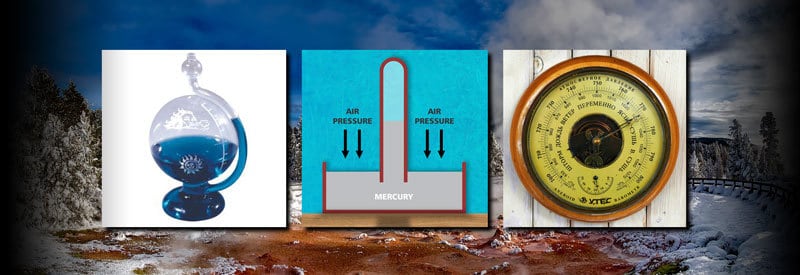
One of the most crucial functions of any weather station is the ability to measure atmospheric pressure, which is done with a barometer. We examine what it is and its role in determining weather conditions.
A barometer is a meteorological instrument primarily used to measure air pressure in the atmosphere. It forms a crucial part of any weather station and is primarily used with other sensors to measure current and determine future weather conditions. It is also used in aviation to measure altitude.
Barometers have been around for centuries and are used on their own or as part of a larger system. But whether they come on their own or form part of a complex weather station, they play a crucial role in almost all weather-related conditions and occurrences.
This post examines what exactly a barometer is, the different types of barometers, and detail how each one works.
Barometers have evolved through the centuries and come in all shapes and sizes. It is also used in more industries than just the weather and climate sectors. However, it still predominantly remains a meteorological instrument.
You might be wondering why a barometer is such a vital part of any weather measuring device. You can see a detailed explanation of how atmospheric pressure influences the weather in this article.
A Quick History Of Barometers

Evangelista Torricelli
In early 1631, French designer René Descartes described the design of a trial to measure air pressure. Since no evidence of an actual experiment could be found, Evangelista Torricelli is widely acknowledged as the inventor of the barometer in 1643.
Torricelli was the first scientist who concluded that the air in the atmosphere had weight and exerted pressure on objects below it. This argument was not supported and believed by most of his peers, including Galileo.
Torricelli continued to work in secret due to the politics and beliefs of the time. He realized he needed a liquid heavier than water to conduct his experiment. As a result, he successfully used mercury and became known as the inventor of the mercury thermometer.
Blaise Pascal became aware of Torricelli's design, and over time, went on to test and perfect Torricelli's design.
The Different types of barometers
As stated in the introduction, a barometer is a meteorological instrument that measures the atmospheric pressure of air in the environment. It is a crucial part of a weather station and is primarily used in combination with other instruments to determine current and future weather conditions. It is also used to measure altitude
Before looking at how they work, the different types of barometers first need to be identified. Since each barometer functions in a different way, it will then be possible to look at each one separately and describe how it works.
Barometers can be divided into four main types. Each one will be briefly described, and in the next section, we will look at how each one works.
1) Mercury Barometer
Invented by Evangelista Torricelli in 1643, as discussed in the previous section, the mercury barometer is one of the earliest barometers ever designed.
It uses an open flat pan and a sealed vertical glass tube filled with mercury to measure changes in air temperature.
2) Water Barometer
The water barometer we are familiar with today is better known as a weather ball barometer. It was invented by Johann Wolfgang Von Goethe, which is why it is also called the "Goethe Barometer."
This simple device consists of a sealed glass container with a long narrow open spout connected to it. It is partially filled with water.
3) Aneroid Barometer
The aneroid barometer was invented in 1844 by Lucien Vidi, a French physicist. (He was also responsible for developing the barograph.)
It consists of a sealed metal box. One or a series of these chambers are connected to spring, which drives different forms of measuring indicators.
4) Digital Barometer
These electronic devices are widely used in modern homes and professional weather stations, as well as various modern appliances.
It consists of a detection cell that is sensitive and responds to air pressure.
Just remember, a barometer is just one small part of a weather station, which consists of a number of sensors measuring the different weather components. To find out what a weather station measures, and the sensors they use, read the following detailed article.
The 4 instruments just discussed are the most common and relevant types of barometers. (There are other types of barometers, but the ones mentioned are the most significant.) Now that the most relevant devices were identified, we can examine how each one works.
How Does A Barometer Work?
All barometers are designed to measure atmospheric pressure. However, each one use a different method of measuring, and also use unique components in its design.
1) How A Mercury Barometer Works
A mercury barometer (also known as a Torricellian barometer) consists of an open flat container filled with mercury. A glass tube with one end sealed is placed in the center of the container. The open end is positioned at the bottom inside the mercury.
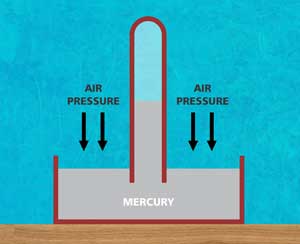
As the air temperature increases, it pushes down on the mercury inside the container, forcing the mercury in the glass tube to rise. When the air temperature drops, the opposite happens, and as the downward pressure decreases, the mercury in the tube drops as well.
The glass tube is calibrated and has measurement marks on its side to accurately record pressure readings.
2) How A Water Barometer (Weather Ball Barometer) Works
The weather ball thermometer consists of a sealed glass container. A long narrow spout with an open end is connected to its side of the container. It is normally shaped to curve up and around the side of the bowl.
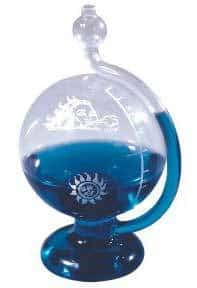
The glass container is partially filled with water-based liquid. As air pressure increases, it pushes the water in the spout down. When air pressure decreases, less weight is put on the water, and the liquid in the spout rises.
Some sealed glass barometers have measurement markings on the glass container. The simple reason for this is that the water in the bowl rises as it is pushed down in the spout and lowers as the water in the spout rises.
A properly calibrated container with measurement markings helps to make a more accurate and consistent recording of the air pressure.
3) How Aneroid Barometer Works
An aneroid barometer consists of one or more sealed metal capsules. The sealed container connects to a spring under tension. In turn, the spring is directly or indirectly connected to a series of mechanical levers. The levers drive the barometer's needle (or similar indicator).
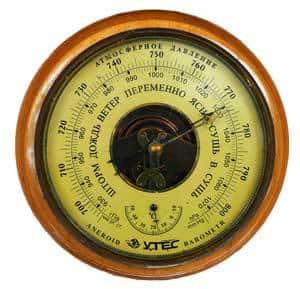
As air pressure increases, more for force is put on the metal container and causes it to contract. This leads to a change in the tension of the spring, which directly affects the mechanic levers. This change is reflected by the needle on the display of the barometer.
The opposite occurs when the air pressure decreases and allows the metal container to expand. The change is again reflected as the needle moves in the appropriate direction on the display face.
The round aneroid barometer (similar in appearance to a clock) remains one of the most widely used and most recognizable barometers. It is still popular with home weather enthusiasts and used by many professional weather services.
4) How A Digital Barometer Works
A digital (or electronic) barometer makes use of a detection cell to measure the air temperature. This cell is sensitive to atmospheric pressure, which influences its capacity to conduct/relay electricity.
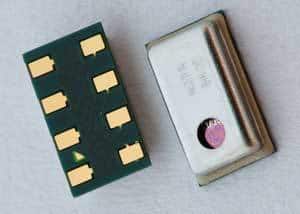
The changing capacity impacts the strength of the electrical current flowing through it, which is measured to calculate the air pressure. Detection cells are small and versatile and can be integrated into a variety of devices for various purposes.
Most home weather stations use them, and they can even be found in a number of smartphones.
Where To place A Barometer
A barometer is designed to be placed indoors or outdoors, depending on your needs.
When placing your barometer, it is important to keep the following in mind:
- Always place a barometer in a shaded area.
- Do not place it close to any source of heat.
- Avoid areas that experience wind or drafts.
- Use a stable surface to place it on or against to avoid knocks and bumps.
Conclusion
As you would have gathered by now, barometers came a long way since Evangelista Torricelli invented the first one in 1643. They come in all shapes and sizes, have different characteristics, and operate in different ways.
This article defined what a barometer is, focused on the four major types of barometers, how they work, and where to place them.
Never miss out again when another interesting and helpful article is released and stay updated, while also receiving helpful tips & information by simply clicking on this link .
Until next time, keep your eye on the weather!

